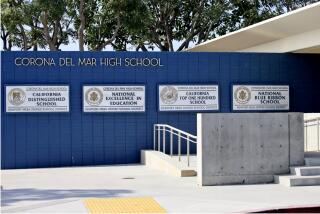Pact Ends Group’s Effort Against New High School
- Share via
Opponents of San Juan Capistrano’s first new public high school in four decades have agreed to stop trying to block its construction in return for not having to reimburse the city and school district for court costs associated with their unsuccessful lawsuit, officials announced Wednesday.
A judge had ruled that San Juan Capistrano resident Lon Uso and a slow-growth advocacy group, Citizens Against Uncontrolled San Juan Expansion, must pay $5,000 to the Capistrano Unified School District and $4,000 to the city to reimburse them for lawsuit-related documents.
“This settlement is basically a burying of the hatchet and moving forward in a positive direction for the students, the community and the school district,” said David Doomey, the district’s associate superintendent of facilities planning. “Now we can put all of our energy and our money into the positives.”
Plans for the 2,000-student campus had divided the community since voters in November rejected the proposed Whispering Hills housing development, including the high school, on the city’s east end, and the school district stuck to its plans to build the school.
Members of the slow-growth group had contended that voter opposition to the 175-home Whispering Hills project also included rejection of the school. A judge briefly halted work on the campus before ruling the organization did not have the power to block the school, which is slated to open in fall 2005.
Uso said Wednesday he was resigned to the settlement’s condition that he no longer speak in opposition to the school.
“The damage is done,” he said. “There is not a whole lot I can do about it at this point in time. We intend to do nothing that will slow down the building of the high school.”
He added that he was proud of what the organization had tried to accomplish.
“We did everything we could to represent the wishes of the voters of San Juan Capistrano,” Uso said. “But we don’t have the financial resources of the school district or the city.”
About a fourth of the grading of the site has been completed.
More to Read
Sign up for Essential California
The most important California stories and recommendations in your inbox every morning.
You may occasionally receive promotional content from the Los Angeles Times.










